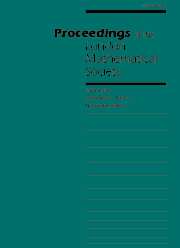On the Structure of Modular Categories
Published online by Cambridge University Press: 26 September 2003
Abstract
For a braided tensor category ${\cal C}$ and a subcategory ${\cal K}$ there is a notion of a centralizer $C_{\cal C}({\cal K})$, which is a full tensor subcategory of ${\cal C}$. A pre-modular tensor category is known to be modular in the sense of Turaev if and only if the center ${\cal Z}_2({\cal C})\equiv C_{\cal C}({\cal C})$ (not to be confused with the center ${\cal Z}_1$ of a tensor category, related to the quantum double) is trivial, that is, consists only of multiples of the tensor unit, and $\dim{\cal C}\ne 0$. Here $\dim{\cal C} = \sum_i d(X_i)^2$, the $X_i$ being the simple objects.
We prove several structural properties of modular categories. Our main technical tool is the following double centralizer theorem. Let ${\cal C}$ be a modular category and ${\cal K}$ a full tensor subcategory closed with respect to direct sums, subobjects and duals. Then $C_{\cal C}(C_{\cal C}({\cal K})) = {\cal K}$ and $\dim{\cal K}\cdot\dim C_{\cal C}({\cal K}) = \dim{\cal C}$.
We give several applications.
(1) If ${\cal C}$ is modular and ${\cal K}$ is a full modular subcategory, then ${\cal L}=C_{\cal C}({\cal K})$ is also modular and ${\cal C}$ is equivalent as a ribbon category to the direct product: ${\cal C}\simeq{\cal K}\boxtimes{\cal L}$. Thus every modular category factorizes (non-uniquely, in general) into prime modular categories. We study the prime factorizations of the categories $D(G)$-Mod, where $G$ is a finite abelian group.
(2) If ${\cal C}$ is a modular $*$-category and ${\cal K}$ is a full tensor subcategory then $\dim{\cal C}\ge\dim{\cal K}\cdot\dim {\cal Z}_2({\cal K})$. We give examples where the bound is attained and conjecture that every pre-modular ${\cal K}$ can be embedded fully into a modular category ${\cal C}$ with $\dim{\cal C}=\dim{\cal K}\cdot\dim {\cal Z}_2({\cal K})$.
(3) For every finite group $G$ there is a braided tensor $*$-category ${\cal C}$ such that ${\cal Z}_2({\cal C})\simeq\mbox{Rep}\,G$ and the modular closure/modularization $\overline{\cal C}$ is non-trivial.
- Type
- Research Article
- Information
- Proceedings of the London Mathematical Society , Volume 87 , Issue 2 , September 2003 , pp. 291 - 308
- Copyright
- 2003 London Mathematical Society
Footnotes
- 125
- Cited by


